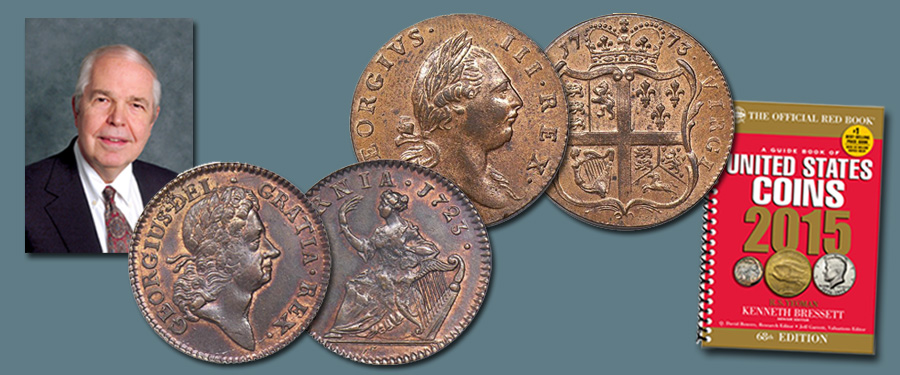
Welcome to the latest installment of my tour through the 2015 edition of A Guide Book of United States Coins. I started at the beginning of this best-selling book and now start on page 44 with Wood’s Hibernia coinage.
As mentioned earlier, William Wood, a British entrepreneur, received a franchise or patent from King George to make coins for distribution in the American colonies. These are the Rosa Americana issues delineated on pages 41 through 44 of the Guide Book. By all logic, the coins discussed in this week’s column, Wood’s Hibernia pieces, have no place in American numismatics. Hibernia is the ancient name for Ireland. Wood had a franchise to strike copper farthings and halfpence for distribution in Ireland, nothing to do with America at all. However, by adoption, if that is the proper word, American numismatists who desired and appreciated Rosa Americana coins, took notice of the Hibernia pieces as well. The obverse motif with the portrait of the king is similar.
Coins were made in quantity from 1722 to 1724 and were indeed distributed in Ireland. The Guide Book states, “Hibernia coins were unpopular in Ireland, so some of these were sent to the American colonies.” I am not sure we have much evidence of this, other than some stray pieces being located here in later years — sent over with British halfpence and other copper coins as a matter of routine (not because British halfpence were unpopular in the British Isles). Be that as it may, Wood’s Hibernia coppers are very collectible today. The Guide Book listing gives basic types, most of which are inexpensive in such grades as Fine and Very Fine. The two pattern pieces can be ignored.
On page 45 are Virginia halfpence or halfpennies – take your choice of words. These were authorized in 1773 by the British crown and were intended for distribution in the colony of Virginia. These were made in large numbers and sent here, after which they found wide use in commerce. It has not been until recent years when metal detectorists have found a number of such pieces in the ground, that the extent of circulation has been fully appreciated. Most often seen in numismatic channels are coins in higher grades, typically Mint State with some spotting, from a famous hoard that was once owned by Colonel Mendes I. Cohen, a Baltimore collector in many fields. In 1956 the American Numismatic Society published Eric P. Newman’s Coinage for Colonial Virginia, which today remains the standard reference. Die varieties are attributed by Newman numbers. Most numismatists seek but a single example of the Virginia halfpenny or, alternatively, two varieties, one with a period after GEORGIVS on the obverse. Beyond this there are many other less distinctive varieties, as enumerated in the Newman text. Also part of the Virginia coinage is the larger diameter 1773 “penny,” the exact nature of which is not known, and the 1774 silver striking referred to as a shilling. The last was only made in Proof form for collectors’ cabinets or as a pattern. Only a handful of pieces are known to exist today.
I’ll see you next week when I will continue with Elephant tokens.





